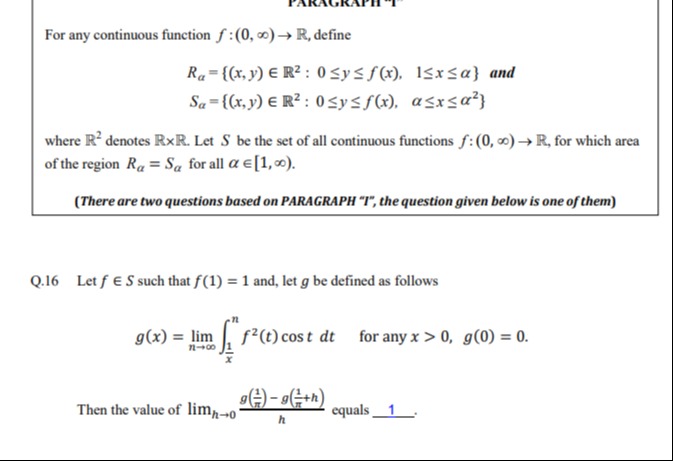Question
Question: For any continuous function $f:(0, \infty) \rightarrow \mathbb{R}$, define $R_{\alpha}=\{(x, y) \in...
For any continuous function f:(0,∞)→R, define
Rα={(x,y)∈R2:0≤y≤f(x),1≤x≤α} and Sα={(x,y)∈R2:0≤y≤f(x),α≤x≤α2}
where R2 denotes R×R. Let S be the set of all continuous functions f:(0,∞)→R, for which area of the region Rα=Sα for all α∈[1,∞).
Let f∈S such that f(1)=1 and, let g be defined as follows
g(x)=limn→∞∫x1nf2(t)cost dt for any x>0,g(0)=0.
Then the value of limh→0hg(π1)−g(π1+h)

1
Solution
The condition for a function f:(0,∞)→R to be in the set S is that the area of the region Rα is equal to the area of the region Sα for all α∈[1,∞).
The area of Rα is given by ∫1αf(x)dx. The area of Sα is given by ∫αα2f(x)dx. So, for f∈S, we have ∫1αf(x)dx=∫αα2f(x)dx for all α∈[1,∞).
Let F(x)=∫1xf(t)dt. The condition is F(α)−F(1)=∫αα2f(x)dx. Since F(1)=∫11f(t)dt=0, we have F(α)=∫αα2f(x)dx for all α∈[1,∞).
Differentiating both sides with respect to α using the Leibniz integral rule: dαd∫1αf(x)dx=f(α)⋅dαdα−f(1)⋅dαd1=f(α). dαd∫αα2f(x)dx=f(α2)⋅dαd(α2)−f(α)⋅dαdα=f(α2)⋅(2α)−f(α)⋅1=2αf(α2)−f(α).
Equating the derivatives, we get f(α)=2αf(α2)−f(α), which simplifies to 2f(α)=2αf(α2), or f(α)=αf(α2) for all α∈[1,∞).
We are given that f∈S and f(1)=1. We need to find a function f that satisfies f(α)=αf(α2) for α∈[1,∞) and f(1)=1. Let's try a power function f(x)=xp. Substituting into the functional equation: αp=α(α2)p=αα2p=α1+2p. For this to hold for all α∈[1,∞), the exponents must be equal: p=1+2p, which gives p=−1. So, f(x)=x−1=x1 is a potential solution. Let's check if f(1)=1: f(1)=11=1. This condition is satisfied. Let's verify if f(x)=x1 satisfies the area condition for α∈[1,∞): ∫1αx1dx=[ln∣x∣]1α=lnα−ln1=lnα. ∫αα2x1dx=[ln∣x∣]αα2=ln(α2)−lnα=2lnα−lnα=lnα. Since lnα=lnα for α∈[1,∞), the area condition is satisfied. Thus, the function f∈S with f(1)=1 is f(x)=x1.
Now, consider the function g(x)=limn→∞∫x1nf2(t)cost dt for x>0. This is an improper integral g(x)=∫x1∞f2(t)cost dt. Substitute f(t)=t1: g(x)=∫x1∞t2costdt. The integral ∫a∞t2costdt converges absolutely for any a>0, since ∣t2cost∣≤t21 and ∫a∞t21dt=[−t1]a∞=a1, which is finite. Thus, g(x) is well-defined for x>0.
We need to evaluate limh→0hg(π1)−g(π1+h). This expression is the negative of the derivative of g(x) evaluated at x=π1. Let x0=π1. The limit is −dxdgx=x0.
To find dxdg, we use the Leibniz integral rule for differentiating with respect to the lower limit. Let H(u)=∫u∞k(t)dt. Then dudH=−k(u). In our case, k(t)=f2(t)cost=t2cost, and the lower limit is u=x1. So g(x)=∫x1∞t2costdt. Using the chain rule, dxdg=dudgdxdu, where u=x1. dxdu=−x21. dudg=−u2cosu. So, dxdg=(−u2cosu)(−x21)=(1/x)2cos(1/x)x21=1/x2cos(1/x)x21=x2cos(1/x)x21=cos(1/x).
Wait, let's recheck the differentiation using Leibniz rule for ∫a(x)b(x)k(t)dt. dxd∫a(x)b(x)k(t)dt=k(b(x))b′(x)−k(a(x))a′(x). Here, a(x)=x1, b(x)=∞. We treat the upper limit as a constant for differentiation purposes, assuming the convergence allows this. g(x)=∫x1∞f2(t)costdt. Let the antiderivative of f2(t)cost be Φ(t). Then g(x)=[Φ(t)]x1∞=limN→∞Φ(N)−Φ(x1). dxdg=dxd(limN→∞Φ(N))−dxdΦ(x1). Assuming the limit term's derivative is 0 (which is true if the integral converges to a constant value with respect to x), we have: dxdg=−Φ′(x1)⋅dxd(x1). Since Φ′(t)=f2(t)cost, we have Φ′(x1)=f2(x1)cos(x1). dxd(x1)=−x21. So, dxdg=−f2(x1)cos(x1)⋅(−x21)=f2(x1)cos(x1)x21.
This matches the previous calculation. We need to evaluate this derivative at x=π1. dxdgx=π1=f2(1/π1)cos(1/π1)(1/π)21=f2(π)cos(π)π2. Since f(x)=x1, f(π)=π1. dxdgx=π1=(π1)2cos(π)π2=π21(−1)π2=−1.
The required limit is limh→0hg(π1)−g(π1+h). This is equal to −dxdgx=π1. So, the value is −(−1)=1.
Therefore, the value of the limit is 1.
